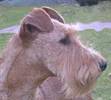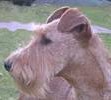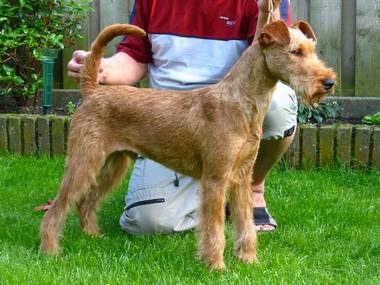|
|
Judging Irish Terriers
Ned's Pride v Koudenhoven (Imp Ned) in show pose.
Written by Neridah Sharrett
of Anluan Kennels
Much has been written about this breed that is not correct. In recent times I have seen articles that, put simply, have not got the standard right. This is not a dog of extremes, it is a dog of moderation and balance. It should not resemble a *cleverly made hunter, as is desired in Wire Fox Terriers and Airedales. To be looking for a small red Airedale is doing the breed a great injustice. It is the standard that sets this breed apart from the rest.
Your first impression should be of a lithe, agile dog built on racy, elegant lines possessing substance in bone and muscle. He is an athlete of great grace, there is nothing clumsy, cloddy or course about this dog. His lines should flow together without evidence of stopping and starting. There should not be an overly angular appearance. On the move he should cover ground with ease and not be heavy footed, stilted in gait or loose in action.
Head and Skull: Head long, skull flat, rather narrow between the ears, narrowing towards the eye. Free from wrinkles; stop hardly visible except in profile. Jaw strong and muscular but not too full in cheek, and of good length. Foreface not dished or falling away quickly between eyes, delicately chiselled. Lips well fitting and externally almost black in colour. Nose black.
Look out for bumpy skulls that show evidence of hollows above the eyes. The skull being flat between the ears is preferred, the overly prominent occiput is unattractive and usually accompanies a narrow head. The brow must not be heavy( like in Scotties) it should blend with the rest of the head, when viewed in profile the head is almost level, with the stop being hardly visible. Viewed front on the head is ever so slightly wedge shaped, however this should not result in a weak muzzle. Eyes: Dark, small, not prominent. A light or yellow eye highly undesirable.
Eyes should be almond shaped not round, and should give loads of expression. When faced with a challenge they should be capable of delivering a ‘dirty look’. Ears: Small and V-shaped, of moderate thickness, set well on head, and dropping forward closely to cheek. Top of ear folded well above the level of the skull. Ear must be free of fringe and hair thereon shorter and darker in colour than body.
Ears that are too thin tend to lack lift, as do large ears. Small thick ears tend to sit too high, lifting off the head. Some ears have dents in the back of them or folds down the front of them, this is not as desirable as ears that have nice rounded ‘bells’ and flat leathers free of folds and creases. Ears can be difficult during teething and may need training by gluing. Some ears are the same colour as the dog, the darker ears set off the expression and are the icing on the cake. Ears usually have the inside hair trimmed out for showing.
Well-placed ears and good eyes are the vital ingredients for good expression. Mouth: Teeth even, strong and free from discolouration. Jaws strong, with perfect, regular scissor bite, i.e. the upper teeth closely overlapping the lower teeth and set square to the jaws. Terriers should have big teeth and although the standard is not specific, it is preferred that they have full dentition. If teeth are missing this should be taken into consideration when judging the overall quality of the dog. There is good evidence to suggest that it is not difficult to breed teeth back into dogs but the numbers of teeth missing and the number of generations affected needs to be carefully considered. Neck: Fair length and gradually widening towards shoulders, well carried and free of throatiness. Generally a slight fringe at each side of neck, running nearly to corner of ear.
A well-groomed dog will have the fringe trimmed very short as it gives a cleaner appearance to the line of the neck. The presence of a frill or fringe is indicative of a lazy trimmer.
Forequarters: Shoulders fine, long and well laid back. Legs moderately long, well set from shoulders, perfectly straight, with plenty of bone and muscle; elbows working freely clear of sides, pasterns short and straight, hardly noticeable. The forelegs moved straightforward when travelling.
The Irish terrier has equal length of upper arm to shoulder, unlike the fox terrier or the Airedale terrier. The ‘terrier front’ so coveted in these breeds is incorrect in the Irish Terrier. There should be a moderate amount of pro-sternum present. The muscles over the shoulder should be long and flat, short thick muscles are unsightly and usually indicate an upright shoulder. If the legs look too long or too short they probably are, the standard is calling for moderate length of leg, this is balanced out by moderate length of body.
Body: Chest deep and muscular, neither full nor wide. Body moderately long, back strong and straight, with no appearance of slackness behind the shoulders, loin muscular and slightly arched, ribs fairly sprung, rather deep than round, and well ribbed back.
The Irish Terrier should not be short in back like the fox terrier or Airedale. Conversely, if it looks long then that is also incorrect. The standard is asking for something in between. The length of back should be determined by the overall picture, no one part should look out of place by being too long or too short. The depth and length of rib combined with the length of loin should combine with a nice tuck up to give the dog its racy appearance. The arch in the loin is only very slight, if the tail appears to be falling off the dog then there is either too much arch to the loin or the dog has a bad tail set, either way the arch in the loin should hardly be noticed.
Hindquarters: Strong and muscular, thighs powerful, hocks well let down, stifles moderately bent. Hind legs moved straight forward when travelling, hocks not turned outwards. Hair on legs dense and crisp.
Irish Terriers do not stand over a lot of ground, they should have a nice turn of stifle with good depth to the second thigh. Skinny second thighs which are too narrow above the hock do not deliver the power to propel the dog adequately. Hocks should be nice and short as this adds to their drive. The hair on the legs should be dense and crisp, long hair is usually soft (and can indicate a soft coat), absence of leg hair is also wrong and might indicate a coat that is either too harsh or is single (no undercoat).
Feet: Strong, tolerably round, moderately small, toes arched, neither turned out nor in; black toenails most desirable. Pads sound and free from cracks or horn excrescences. Judges should at least check for cracked or corny pads. Horny excrescences (which resemble another digit growing) have not been seen in Australia since the 1970’s but it is still present in other countries. Vigilance is important and judges should become accustomed to checking. This is a crippling condition with no cure. Tail: Preferably docked to about three quarters, free of fringe or feather but well covered with rough hair, set on pretty high carried gaily but not over the back nor curled.
Note that in Australia we no longer dock tails, when looking at tails it is important to look for set on first, sure a straighter tail is nice but the set on is more important. If you are not used to judging undocked tails you will need to get past the extra length, it is not fair to penalise a good dog because of your personal preference regarding tail length.
Also note that when sparring with other dogs the Irish Terrier tail can go very stiff and can sometimes come over the back more than is normal for that dog. The fast moving, stiff tail is a good indicator that the Irish is getting serious. Gait/Movement: Fore and hind legs carried straight forward and parallel. Elbows move perpendicular to body, working free of sides, stifles neither turning in nor out,
The breed standard is not calling for convergence (coming to a centre line) of the legs at speed. Irish Terriers should move with front and back legs travelling straight forward. When moving away from you, you should see the front legs framed by the rear legs. Hocks should not turn in or out. In profile they should cover ground equally in front and rear, showing reach and drive.
Coat: Harsh and wiry, having a broken appearance, free of softness or silkiness, not so long as to hide the outline of the body, particularly in hindquarters, straight and flat, no shagginess and free of lock or curl. At base of these stiff hairs is growth of finer and softer hair, usually termed the undercoat. Hair on foreface crisp and only sufficiently long to impart appearance of additional strength. Hair on legs dense and crisp.
Irish Terriers do not have the profuse coat that Wire Fox terriers and Airedales have. Also, they have much less under coat, which can sometimes be difficult to find. Coats that are too harsh lack leg and face hair as well as undercoat, they are at risk of producing kinky coated puppies. Coats that are too soft can have profuse leg and face hair. Coats that are slightly wavy are usually harsh, when trimmed tight they will appear straight but get wavy as the hair gets longer.
Colour: ‘Whole coloured’ most preferable colours being red, red wheaten, or yellow red. Small amount of white on chest is acceptable, white feet highly undesirable. Black shading highly undesirable.
Note, many Irish Terriers carry a small black patch half way up their tails, this is thought to relate to an ancient scent gland, if stripped it is usually bare underneath. This patch is not of great consequence. The Irish Terrier coat is not solid coloured all the way from tip of hair to root, the colour and texture of the coat is carried in the very tip of the hair, it is normal to get some lighter and darker tones through a coat.
Size: Ideal height for dogs is 48cms (19 inches) and for bitches it is 46cms (18 inches). Faults: Any departure from the foregoing points should be considered a fault and the seriousness with which the fault should be regarded should be in exact proportion to its degree.
Note: Male animals should have two apparently normal testicles fully descended into the scrotum.
Neridah Sharrett Canning Vale, WA, Australia Phone : 08 9455 1059 Email : [email protected] |


